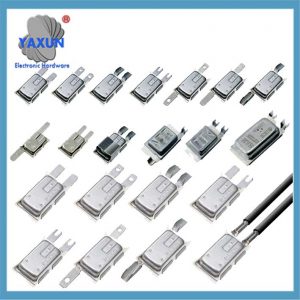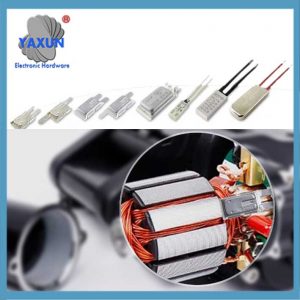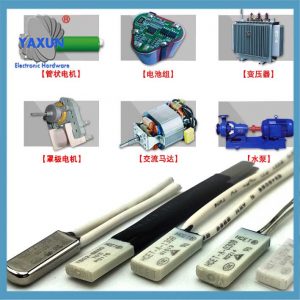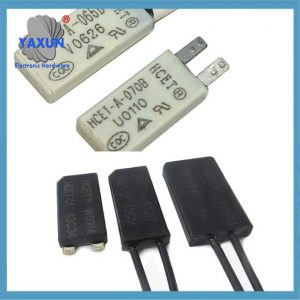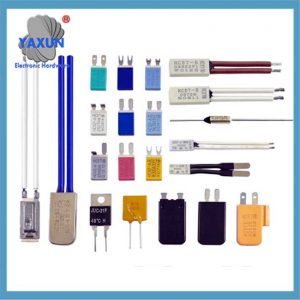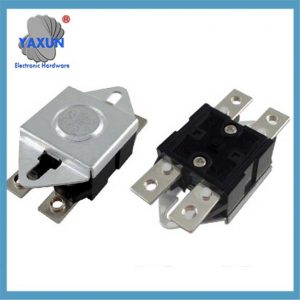Bộ bảo vệ quá nóng là một thiết bị điều khiển tự động đạt được bảo vệ an toàn thiết bị thông qua giám sát nhiệt độ. Chức năng cốt lõi của nó là cắt mạch hoặc kích hoạt cơ chế bảo vệ khi nhiệt độ vượt quá ngưỡng tập hợp để ngăn thiết bị bị trục trặc hoặc gây ra hỏa hoạn do quá nóng. Sau đây là các chi tiết kỹ thuật và phân tích ứng dụng của nó:
1. Nguyên tắc và loại
Cấu trúc dảibimetallic: Sử dụng hai tấm composite kim loại với các hệ số giãn nở nhiệt khác nhau, Biến dạng kích hoạt hành động tiếp xúc khi nhiệt độ tăng (Thông thường mở/thường bị đóng loại).
Tự phục hồi và không phục hồi bản thân:
Loại tự phục hồi: tự động đặt lại sau khi nhiệt độ giảm (chẳng hạn như tủ lạnh, máy giặt);
Loại không tự phục hồi: Đặt lại thủ công là bắt buộc (chẳng hạn như động cơ nhiên liệu, Thiết bị công nghiệp).
Thermistor liên kết: Một số mô hình kết hợp các máy điều nhiệt hoặc máy vi tính đơn chip để đạt được kiểm soát nhiệt độ chính xác.
Cách nó hoạt động:
Cảm biến:
Các thiết bị bảo vệ quá nhiệt thường sử dụng cảm biến nhiệt độ (như nhiệt điện trở hoặc dải lưỡng kim) Để theo dõi nhiệt độ của một khu vực cụ thể.
Ngưỡng:
Khi nhiệt độ vượt quá ngưỡng đặt trước, Cảm biến kích hoạt tín hiệu.
Hoạt động:
Tín hiệu này sau đó kích hoạt bộ ngắt mạch, tiếp sức, hoặc cơ chế khác để ngắt kết nối nguồn điện hoặc giảm công suất của thiết bị.
2. Key tham số và lựa chọn
Phạm vi nhiệt độ: Nhiệt độ hành động phổ biến 40-180 ℃ (chẳng hạn như dung sai sê -ri KSD9700 ± 3/5 ℃);
Dòng điện/điện áp: Thông số kỹ thuật điển hình AC250V/5A, Các mô hình điện áp cao có thể đạt đến AC1800V;
Hình thức cấu trúc:
Vỏ nhựa (Vật liệu PBT, Nhẹ);
Vỏ kim loại/gốm (kháng nhiệt độ cao, cách nhiệt).
3. Kịch bản ứng dụng chính thức
Housekeep thiết bị: Động cơ điều hòa không khí, máy giặt, vân vân., Để ngăn chặn cuộn dây động cơ quá nóng; Thiết bị công nghiệp: Giám sát nhiệt độ cuộn dây máy bơm chìm (chẳng hạn như người bảo vệ GB-220V); Mạch điện tử: Bộ xử lý bảo vệ tản nhiệt để tránh các lỗ hổng tấn công nhiệt độ cao. Ví dụ về các thiết bị bảo vệ quá nhiệt:
Bộ bảo vệ nhiệt trong động cơ:
Các thiết bị này được nhúng trong động cơ điện để ngăn chặn quá nhiệt, có thể khiến động cơ bị hỏng hoặc bắt lửa.
Cabin bảo vệ quá nhiệt trong xe:
Một số phương tiện, Giống như Tesla, Có một tính năng bảo vệ quá nóng cabin tự động kích hoạt điều hòa để ngăn nội thất nóng một cách nguy hiểm khi đỗ.
4. Bộ điều nhiệt PTC trong thiết bị điện tử:
Chúng được sử dụng trong một loạt các ứng dụng để bảo vệ các mạch khỏi quá nóng bằng cách tăng đáng kể điện trở của chúng khi vượt quá nhiệt độ nhất định.
Bộ giới hạn nhiệt độ trong hệ thống sưởi ấm:
Những thiết bị này, Giống như bản mô tả trong bài viết của HeatSystems, được sử dụng để ngăn chặn các yếu tố sưởi ấm không quá nóng, có thể làm hỏng phần tử sưởi hoặc vật liệu xung quanh.
Tầm quan trọng của bảo vệ quá nóng:
Sự an toàn: Ngăn chặn đám cháy, Thiệt hại thiết bị, và chấn thương tiềm ẩn do quá nóng.
Độ tin cậy: Đảm bảo tuổi thọ và hoạt động đúng của các thiết bị và hệ thống.
Hiệu quả: Trong một số trường hợp, Giống như trong xe, Bảo vệ quá nhiệt có thể giúp tối ưu hóa việc sử dụng năng lượng.
5. Các vấn đề và các biện pháp phòng ngừa
Yêu cầu cài đặt: Cần phải gần với bề mặt của thiết bị được kiểm soát để tránh biến dạng vỏ ảnh hưởng đến hiệu suất;
Risk của hoạt động sai: Lão hóa hàn hoặc thiệt hại cơ học có thể gây ra sự cố bảo vệ;
Sự khác biệt từ bảo vệ quá tải: Bảo vệ quá nhiệt dựa trên ngưỡng nhiệt độ, trong khi bảo vệ quá tải phản ứng với sự bất thường hiện tại.
6. Xu hướng phát triển công nghệ
Thiết kế emated: Chẳng hạn như bộ bảo vệ lưỡng kim loại nhảy kết hợp với các chức năng kép quá dòng/quá nóng;
Cải thiện độ tin cậy cao: Bao bì gốm và mạch chống can thiệp cải thiện khả năng thích ứng với môi trường công nghiệp.
 English
English Afrikaans
Afrikaans العربية
العربية বাংলা
বাংলা bosanski jezik
bosanski jezik Български
Български Català
Català 粤语
粤语 中文(简体)
中文(简体) 中文(漢字)
中文(漢字) Hrvatski
Hrvatski Čeština
Čeština Nederlands
Nederlands Eesti keel
Eesti keel Suomi
Suomi Français
Français Deutsch
Deutsch Ελληνικά
Ελληνικά हिन्दी; हिंदी
हिन्दी; हिंदी Magyar
Magyar Bahasa Indonesia
Bahasa Indonesia Italiano
Italiano 日本語
日本語 한국어
한국어 Latviešu valoda
Latviešu valoda Lietuvių kalba
Lietuvių kalba македонски јазик
македонски јазик Bahasa Melayu
Bahasa Melayu Norsk
Norsk پارسی
پارسی Polski
Polski Português
Português Română
Română Русский
Русский Cрпски језик
Cрпски језик Slovenčina
Slovenčina Slovenščina
Slovenščina Español
Español Svenska
Svenska ภาษาไทย
ภาษาไทย Türkçe
Türkçe Українська
Українська اردو
اردو Tiếng Việt
Tiếng Việt

